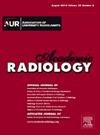BMSMM-Net:基于曼巴和多视角提取的骨转移分割框架。
IF 3.8
2区 医学
Q1 RADIOLOGY, NUCLEAR MEDICINE & MEDICAL IMAGING
引用次数: 0
摘要
理由和目的:转移性骨肿瘤显著降低患者的生活质量并加速癌症的扩散。传统的诊断方法依赖于放射科医生耗时的手工注释,容易出现主观性。利用深度学习快速、精确地分割骨转移瘤可以极大地改善患者的预后和生存率。然而,由于成骨、溶骨或混合性病变的多样性和复杂性,准确的分割仍然具有挑战性。材料和方法:在这项研究中,我们提出了一个新的分割框架,称为BMSMM-Net,专门用于检测骨转移。该框架将我们新提出的瓶颈门控曼巴层(BGM)集成到网络骨干网中,增强了深度特征图中的远程依赖关系。此外,我们在跳跃连接上设计了一个跳跃-曼巴(SKM)模块,以便在多尺度特征融合过程中进行远程建模。此外,在特征提取阶段采用了多视角提取(MPE)模块,利用三种不同大小的卷积核来增强对骨转移的敏感性。结果:我们的框架通过对比和消融研究在BM-Seg数据集上进行了评估。BMSMM-Net对骨转移瘤和骨区域的分割F1得分分别为91.07%和95.17%,mIoU得分分别为83.60%和90.78%,为骨转移瘤的分割提供了高性能。此外,与现有模型相比,它保持了良好的计算效率。结论:BMSMM-Net框架整合了BGM、SKM和MPE模块,有效解决了骨转移的分割难题。它大大提高了准确性,优于先进的现有方法,并保持较低的复杂性,使其适合临床应用。本文章由计算机程序翻译,如有差异,请以英文原文为准。
BMSMM-Net: A Bone Metastasis Segmentation Framework Based on Mamba and Multiperspective Extraction
Rationale and Objectives
Metastatic bone tumors significantly reduce patients’ quality of life and expedite cancer spread. Traditional diagnostic methods rely on time-consuming manual annotations by radiologists, which are prone to subjectivity. Employing deep learning for rapid, precise segmentation of bone metastases can greatly improve patient outcomes and survival. However, accurate segmentation remains challenging due to the diverse and complex nature of osteoblastic, osteolytic, or mixed lesions.
Materials and Methods
In this study, we presented a novel segmentation framework, termed BMSMM-Net, tailored specifically for the detection of bone metastases. The framework integrates our newly proposed Bottleneck Gating Mamba layer (BGM) into the network backbone, enhancing the long-range dependencies in the depth feature maps. Additionally, we designed a Skip-Mamba (SKM) module on the skip connections to facilitate long-range modeling during multi-scale feature fusion. Furthermore, a Multi-Perspective Extraction (MPE) module was employed in the feature extraction phase, utilizing three different sizes of convolutional kernels to enhance sensitivity to bone metastases.
Results
Our framework was evaluated on the BM-Seg dataset through comparative and ablation studies. It achieved F1 scores of 91.07% and 95.17% for segmenting bone metastases and bone regions, respectively, along with mIoU scores of 83.60% and 90.78%, BMSMM-Net provides high-performance segmentation of bone metastases. Additionally, it maintains good computational efficiency compared to existing models.
Conclusion
The BMSMM-Net framework, integrating BGM, SKM, and MPE modules, effectively addresses the segmentation challenges of bone metastases. It significantly enhances accuracy, outperforms advanced existing methods, and maintains lower complexity, making it suitable for clinical application.
求助全文
通过发布文献求助,成功后即可免费获取论文全文。
去求助
来源期刊

Academic Radiology
医学-核医学
CiteScore
7.60
自引率
10.40%
发文量
432
审稿时长
18 days
期刊介绍:
Academic Radiology publishes original reports of clinical and laboratory investigations in diagnostic imaging, the diagnostic use of radioactive isotopes, computed tomography, positron emission tomography, magnetic resonance imaging, ultrasound, digital subtraction angiography, image-guided interventions and related techniques. It also includes brief technical reports describing original observations, techniques, and instrumental developments; state-of-the-art reports on clinical issues, new technology and other topics of current medical importance; meta-analyses; scientific studies and opinions on radiologic education; and letters to the Editor.
 求助内容:
求助内容: 应助结果提醒方式:
应助结果提醒方式:


